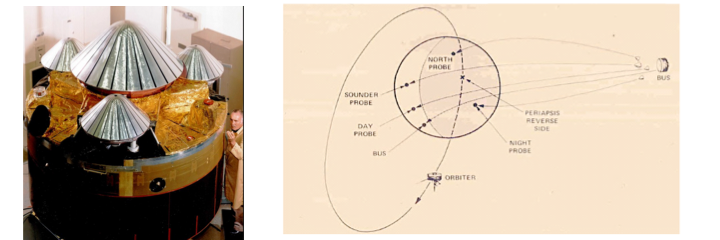
Introduction
The Pioneer Venus Mission consisted of two major parts: the Multiprobe and the Orbiter. The Multiprobe was composed of the carrier or Bus (290 kg); Sounder, a large probe (315 kg) and 3 smaller probes (90 kg each). It was launched on August 8, 1978 and reached Venus on December 9, 1978. Sounder was released from the Bus on November 15, 1978 followed by 3 smaller probes on Nov 19, 1978.
Pioneer Venus Probes and Bus - Atmospheric Entry **
All times in UT (= EST + 5 hours) on December 9, 1978
| Large Probe | North Probe | Day Probe | Night Probe | Bus | |
|---|---|---|---|---|---|
| Entry Time (200 km) | 18:45:32 | 18:49:40 | 18:52:18 | 18:56:13 | 20:21:52 |
| Impact Time | 19:39:53 | 19:42:40 | 19:47:59 | 19:52:05 | * |
| Loss of Signal | 19:39:53 | 19:42:40 | 20:55:34 | 19:52:07 | 20:22:55 |
| Impact Latitude | 4.4 N | 59.3 N | 31.3 S | 28.7 S | (37.9 S) |
| Impact Longitude | 304.0 | 4.8 | 317.0 | 56.7 | (290.9) |
| Solar Zenith Angle | 65.7 | 108.0 | 79.9 | 150.7 | 60.7 |
| Local Venus Time | 7:38 | 3:35 | 6:46 | 0:07 | 8:30 |
| *Bus signal at 110 km altitude | |||||
| ** Information from NSSDC web site. |
The orbiter carried 16 instruments (total mass 45 kg) to study plasma interaction with the upper atmosphere, make multi-wavelength observations of the clouds and to map the surface with radar. It was launched on May 20,1978 and reached orbit on Dec 4, 1978. Entry into the atmosphere ended the mission on Oct 8, 1992. (See NASA SP-461 by Fimmel, Colin and Burgess for a general review of the mission.)
Some achievements during the 14 Year mission were
- A radar map of the surface at 75 Km resolution
- Characterization of Venus’ interaction with the solar wind setting limits on Venus” magnetic field
- Established sulfuric acid content of cloud deck
- Measured a decline in sulfuric acid in the atmosphere and detected implying active volcanic activity
The Venus multiprobes and orbiter investigated Venus before rigorous archiving was an integral part of a NASA mission. As a result, no systematic archive of raw, calibrated and derived products was preserved. Data was preserved in NSSDCA in outdated formats and recent (2024) recovery efforts are producing Special Events Collections
References
The initial descriptions for the mission, its goals and instrumentation is given in
Space Science Reviews, 20(3), 248-354, 1977a. https://link.springer.com/journal/11214/20/3 and Space Science Reviews, 20(4), 356-525, 1977b. https://link.springer.com/journal/11214/20/4
Colin, L., Encounter with Venus, Science, 203, No. 4382, 743-745, Feb. 1979.
An introduction to the JGR special issue covering results is given by Colin, L, The Pioneer Venus Program , Journal of Geophysical Research, VOL. 85, NO. A13, Pages 7575-7598, December 30, 1980, https://doi.org//JA085iA13p07575 which includes a detailed bibliography.
Searching for Additional Publications via Author or topic
Accessing the Data
The Venus multiprobes and orbiter investigated Venus before rigorous archiving was an integral part of a NASA mission. As a result, no systematic archive of raw, calibrated and derived products was preserved. Some data was preserved in NSSDCA and recent (2024) recovery efforts generated the products in this data set. See the user’s guide for description of the data products included in this bundle.
Large Probe Gas Chromatograph (LGC) Data Collection
Large Probe Infrared Radiometer (LIR) Data Collection
Large Probe Solar Flux Radiometer (LSFR) Data Collection
Orbiter Atmospheric Drag (OAD) Observations and Model Data Collection
Orbiter Solar Wind Plasma Analyzer (OPA) Data Collection
Small Probes Net Flux Radiometers (SNFR) Data Collection
Multiprobes Nephelometer (LN/SN) Data Collection
Multiprobes Atmospheric Structure (LAS/SAS) Data Collection
Large Probe Infrared Radiometer (LIR) Data Collection
Large Probe Solar Flux Radiometer (LSFR) Data Collection
Orbiter Atmospheric Drag (OAD) Observations and Model Data Collection
Orbiter Solar Wind Plasma Analyzer (OPA) Data Collection
Small Probes Net Flux Radiometers (SNFR) Data Collection
Multiprobes Nephelometer (LN/SN) Data Collection
Multiprobes Atmospheric Structure (LAS/SAS) Data Collection
Downloading all data files
Citing Datasets for Publications
S.A.McLaughlin, Y.-I Won (2024), Pioneer Venus facial Events Data Bundle, NASA Planetary Data System,
 PDS: The Planetary Atmospheres Node
PDS: The Planetary Atmospheres Node


